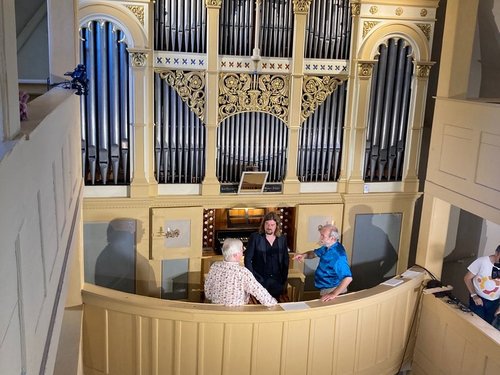Since the beginning of the project in August 2021, video recordings have been used to digitize historical and contemporary organs as well as teaching content, especially on the music and hermeneutics of J. S. Bach's compositions and Max Reger's organ works, often on several days in succession. By the end of October 2022, 66 days of filming will have been completed. The center of the historical organ is the cultural area of Southern Germany, today Central Germany and Southern Germany; it is influenced by France and Italy. Würzburg, for example, was once a stronghold of European organ building in the 18th century. When the warm season arrives, the team with its artistic director, Prof. Dr. h.c. Bossert, is on the road in the churches. For the team of six, each trip is a challenge: no two organs are alike, each historic instrument is an individual, a work of art in itself. Many procedures have to be observed during the production: among others, the individual communication with the respective responsible persons on site, since the organ to be recorded has to be tuned. A script for the respective instrument (including a list of literature, history of the instrument, special features of the instrument), prepared in several hours of preparation time, is the basis for all participants. Prof. Dr. h.c. Bossert works out the organ sounds and their effect on the basis of improvisation and literature, lectures and philosophizes about them. Some of the students also participate with contributions and teaching lessons.
A production day lasts up to 12 hours. If it is too noisy during the day or if guided tours take place in the church, the team works at night. Most of the instruments are located in rural areas, only rarely in a large city, as the 20th century destroyed many organs. In the meantime, historic instruments from Stralsund to Bad Wimpfen have been documented. Now follows a European organ journey to Riga, Holland, France, Italy, Switzerland, Austria up to the whole Eastern European cultural area.
After the rough cut, the videos will be reviewed and commented on with the participation of students and volunteer staff. After the Central Germany production - with the participation of up to 15 participants - the content concept of Prof. Dr. h.c. Bossert is also digitally linked to the organ class of the University of Music Würzburg Weimar. The videos will have English subtitles and musicological background. In the future, they will be made available in a digital teaching library currently under construction, via teaching platforms and homepage. In the meantime, the Iowa College of Music has also been integrated into the existing network.
During the cold season, 18 production days of teaching content on music and hermeneutics were produced on our concert hall organ; meanwhile, it can also be played as a step into the hyper-organ with an additional four separate keyboards. Thanks to an extension application approved by the 'Stiftung Innovation in der Hochschullehre' in September 2022, gaps in organ teaching can furthermore be closed: thus, the teaching of organ art at our university will be supplemented by a Gothic organ in the future; this organ thus closes the gap in the teaching of improvisation and literature of the 'Middle Ages'. Furthermore, an organ model will be used in the future to experience the different construction methods of an organ in a very small space.
Thilo Frank, Coordination DVVLIO

